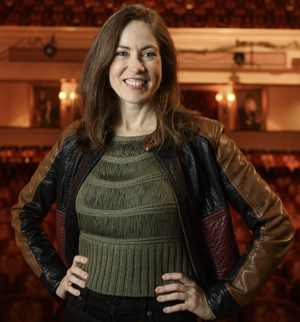Sisterhood Spotlight

Barter Theatre’s Fourth Producing Artistic Director
Katy Brown is Barter Theatre’s Fourth Producing Artistic Director in its 92 year history. Her work in theatre has been as a director, producer, actor, dancer, dramaturg, administrator, designer, choreographer, and technician. She has directed well over 100 professional productions, including The Three Musketeers, Peter and the Starcatcher, Mary’s Wedding, A Streetcar Named Desire, The Miracle Worker, Little Women, The 39 Steps, Great Expectations, Dead Man’s Cell Phone, and Sense and Sensibility, with a special focus on Shakespeare, including Richard III, Romeo and Juliet, Twelfth Night, and Hamlet.
Barter Theatre is known as The State Theater of Virginia. Explain a bit about its history and how it achieved this stature?
Barter Theatre was founded in 1933 by Robert Porterfield, a Broadway actor originally from Southwest Virginia. When he and his actor compatriots found themselves without work in Depression era New York, he invited them to come back with him to Virginia to start a theatre. Money was scarce, but farmers in the region had food they couldn't sell, so Porterfield offered tickets for trade: 35 cents or the equivalent in 'victuals.' The first year, the theatre made less than $5, but there was a collective weight gain of over 350 pounds among the actors, and Barter's plan of "Ham for Hamlet" was off to a roaring start.
Barter Theatre was at the vanguard of the regional theatre movement, a movement built on the idea that great art was for everyone, not just people in large cities. Actors like Gregory Peck, Patricia Neal, Ernest Borgnine, and Ned Beatty got their start at Barter, and audiences came from around the country to see them. Robert Porterfield petitioned the state of Virginia for the title of State Theatre in1946, and it became the first state theatre in America.
As the first woman to serve as Artistic Director in Barter’s nearly 100-year history, what have you learned about leadership, collaboration, and the power of women supporting women in the arts?
I have been lucky to have had powerful, smart, empathetic women by my side throughout my tenure. Barter would not be in the place it is today without the women Board Members, Artistic Directors, team leaders, artists and friends that walked through the last 6 years with me. Through them, I have learned that collaboration and leadership are more alike than different. I have always believed that those two things were linked-- I know now that, when I am at my best, they are nearly identical.
Theater has a unique ability to tell stories that move people and spark change. How do you choose or create productions that elevate women’s voices and experiences?
Story can change the way people see the world more readily than almost anything else can. It has been one of the great privileges of my life to help to create plays that allow audience members to truly, deeply imagine what it would be like to live someone else's story. When those stories are written by or shaped by female artists, it matters. We create and produce quite a lot of new work each year at Barter- our playwright in residence writes several plays a year for the theatre and her voice is a big part of who we are as a company. Our new play festivals stage readings and produce new plays by women, many of our design teams and shops are led by women, and most of our directors are women. Together we look for what feels truly authentic to us-- it's the best way I know to make plays that reflect the real story of women.
For women and girls interested in theater—whether as artists, leaders, or supporters—what resources or opportunities does Barter offer to help them grow and find their place on and off the stage?
One of the greatest joys of working at Barter is getting to work with emerging artists. We have young artists as a part of our resident acting company, in each of our production shops, on design teams, writing our plays, and in administration, too. Barter has mentoring opportunities, and we love to help people across the company hone new skills. When a skill is in the person's main field of expertise, she works daily with new projects and opportunities to stretch her skills. When she is interested in learning something outside her main field, we'll often pair her with someone in the company who can guide her. We have young actors who are branching out in the playwriting (we will produce 2 new plays by 2 first time playwrights from our acting company next season), costume designers choreographing professionally for the first time, dancers studying with the marketing department, and a host of other cross-pollinating projects. One of the exciting things about being in a resident company is that these young women can get hands-on, professional experience in many different facets of theatre that interest them.
About Katy Brown
Katy Brown is Barter Theatre’s Fourth Producing Artistic Director in its 92 year history. Her work in theatre has been as a director, producer, actor, dancer, dramaturg, administrator, designer, choreographer, and technician. She has directed well over 100 professional productions, including The Three Musketeers, Peter and the Starcatcher, Mary’s Wedding, A Streetcar Named Desire, The Miracle Worker, Little Women, The 39 Steps, Great Expectations, Dead Man’s Cell Phone, and Sense and Sensibility, with a special focus on Shakespeare, including Richard III, Romeo and Juliet, Twelfth Night, and Hamlet. She commissioned, produced and directed regional, national and international tours that performed for hundreds of thousands of audience members. Katy was the Director of the Young Playwrights Festival from its creation in 2002 until 2019, leading to the creation of thousands of plays by young people. During the pandemic, she led Barter Theatre to repurpose the Historic Moonlite Drive-In for live productions, so the theatre could serve audiences safely under the stars.